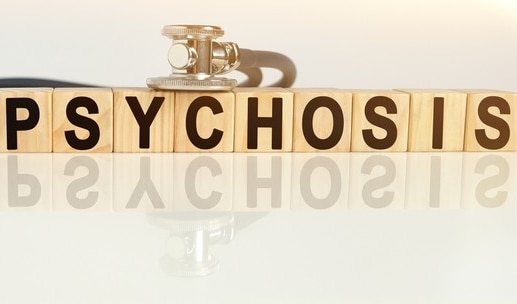Introduction. What is psychosis?

Psychosis is an abnormal psychological condition that affects thoughts and feelings. The condition is not a defined psychiatric diagnosis. Psychiatrists use the term psychosis to describe a group of symptoms which can appear in different mental and physical illnesses.
A person suffering from psychosis may be partially or completely detached from reality. This means that the person has difficulties determining what is real and what is the product of phantasy. Mental health experts describe the psychotic state akin to a psychological condition we experience while dreaming. People suffering of psychosis are like someone who dreams with open eyes.
Psychotic symptoms may appear as delusions (irrational thinking), hallucinations (false sensory perceptions), agitation, sometimes aggressive behaviour or its contrary, as social withdrawal from the real world while the patients feels trapped in the word of phantasy.
Psychiatrists consider psychosis one of the most common causes of social disability in adult men and women. According to DSM-5 psychotic symptoms occur in such disorders as: schizophrenia, schizoaffective disorder, delusional disorder, brief psychotic disorder, substance use disorders, bipolar disorder, and major depressive disorder. Psychotic symptoms can appear also in the context of other psychiatric disorders such as Post-Traumatic Stress Disorder (PTSD), and in several personality disorders.
Psychosis. Signs and symptoms
The most common symptoms of psychosis are delusions and hallucinations. Additional symptoms are incoherent thinking, disorganized speech, erratic and/or inappropriate behaviour. Other symptoms of psychosis, in psychiatric terms called “negative symptoms”, include apathy, diminished emotional expression and social withdrawal.
Delusions
One of the most common symptoms of psychosis are delusions. A delusion is a false belief contradicting reality while resisting any logical explanation or proof. Delusions may include various thematic content. They are context and culture dependent. Delusional themes reflect the current culture of a particular time and place. The DSM-5 characterizes a particular delusion as “bizarre” if it is clearly implausible or inconsistent with the surrounding cultural context.
Types of delusions
The German psychiatrist and philosopher Karl Jaspers proposed to classify psychotic delusions into primary and secondary types. He theorized that primary delusions appear suddenly and that they are irrational in terms of normal psychological processes. Jaspers describes secondary delusions that are influenced by the person’s current situation and personal and cultural background.
Persecutory delusions or paranoia

The most common type of delusions in psychosis are delusions of persecution. Symptoms of persecutory delusions include extreme paranoia, fears, and worries about imminent harm, even though the imaginary threat is unproven or impossible. In this type of delusion, the patient believes that someone (individual, organization, or group) is trying to harm him or his loved one.
These delusions can range from plausible concerns, for example, loud voices in the neighbourhood, the person refers to himself, or infidelity of a spouse, to impossible or highly unlikely stories. The person may believe that he or she is being spied on. He tends to repeat unsubstantiated accusations including police reports. The patient maintains and justifies his delusional ideas by any supporting, even unrealistic evidence, that he can find.
The fear and anxiety that accompanies paranoia is overwhelming. Depending on the severity of the condition, this could lead the sufferer taking radical measures to prevent or defend against the alleged threat. Left untreated, the persecutory delusions tend to get chronic and may persist life log.
Delusions of reference
Referential delusions are one of the most common psychotic symptoms. The term describes an individual’s false belief interpreting ordinary events and normal human behaviour as hidden messages referring to him. People in the grip of referential delusion see themselves at the centre of someone else’s attention and they remain resistant to contrary evidence. These patients are convinced that people or secret services are watching them, talking about them, and planning to harm them. The patient interprets random or disconnected events as hidden message from the persecuting entity. They see themselves as the main protagonist of the story they created, and they perceive this story as real. The delusional scenario is based on defence mechanism called projection. Despite the apparent suffering, being at the centre of a plot supports the Ego which increases the subjective feeling of self-importance of those involved.
Delusions of grandeur or megalomania

Delusions of grandeur are also called megalomania. These delusions are common in the manic phase of bipolar disorder but can be observed in other psychiatric disorders. People who suffer from megalomania see themselves as great, highly skilled, more important than others. They also often feel they are equipped with magical powers. Delusions of grandeur can be persistent or intermittent.
Megalomania is more than simply having self-esteem that is too high. It marks a significant disconnection and alienation from the real world. People with megalomania may continue to believe in their delusions despite the contrary evidence. Psychiatrists note that megalomania may be associated with mental or physical health conditions, such as schizophrenia, bipolar disorder, or some forms of dementia.
A megalomaniac feels an exaggerated sense of importance. Megalomania is a false or abnormal belief in one’s own greatness. For example, a person may believe that he or she is famous or has unlimited power. People who suffer from megalomania see themselves as great, highly skilled, more important than others, and even magical. Delusions can be persistent or intermittent. Some people with megalomania also experience other delusions, such as fear of persecution or unusual religious beliefs. But megalomania is not just about having very high or excessive self-esteem. It marks a significant disconnect from the real world. People with megalomania may continue to believe in their delusions despite conflicting evidence.
Delusions of thought broadcasting

Thought broadcasting is the belief that one’s thoughts are audible. Patients believe that other individuals can overhear and control their thoughts. They may also become convinced that their thoughts can be broadcast on radio, television, or on internet. The patient will conclude that whatever he thinks is transparent to others. Patients with delusions of any type, including thought broadcasting, often do not discuss their symptoms with family or friends. This is especially the case if they keep some confirmation of reality. They wind up living in two worlds: in the real world where they act normally and in their delusional world. Psychiatrist that diagnoses patients with thought broadcasting have found that it can take years to discover this delusion. Even family and friends do not notice the patient’s symptoms. This is a common delusion among patients with schizophrenia.
Thought insertion

This type of delusion is a belief that one’s thoughts are made by someone else, by an external power. Such external entity, believed by the patients to be the “thought Inserter” could be a particular person, an institution, group of people or someone unknown. The person affected thinks that his mind has been intruded and that his thoughts do not belong to him, that they originate in the minds of others. The patient frequently does not even know why inserts the thoughts in his mind, but he is convinced that the insertion process insertion is real. He feels in the power of some incomprehensible external force. Apart of the conviction that someone else “implanted” the thoughts in his mind, the patient may think that this entity also controls his thoughts.
As similar phenomenon happens in intrusive thought in the obsessive – compulsive disorder. The OCD patient is not able to block the thoughts, feeling that they are imposed on him. However, the main difference between thoughts insertion and the obsessive-compulsive thoughts is the absence (thoughts insertion) or presence (OCD thoughts) of the insight. In case of thoughts insertion, the patient has no or little insight that the process of insertion/thoughts control is not real. In the OCD, even though the patient is not able to block the thoughts, he is able to recognizes that they are not a part of his personality and frequently knows that they are nonsensical. The thoughts insertion is Ego-synthym (belonging to Ego) while the OCD thoughts are not regarded as a part of the patient’s personality.
Somatic delusions
A somatic delusion is person’s wrong and not correctable belief that his/her organs or body shape are ill or abnormal. The person can be convinced that the body is not symmetrical, or its parts are distorted. Sometimes a person can be convinced that some part of the body is atrophic (decreased muscle bulk). On other occasion he might think not to be able to move a part of his body or move at all. The imagined but for the patient fully real problem can lead to protecting the imaginary affected part of the body or stopping moving. By not moving his legs, arms, or head can lead to a real muscle atrophy, stiffness of the joints; abandoning walking can cause a full invalidism.
Another frequent theme of somatic delusion is the conviction that the body is affected by germs or parasites. The patients affected by such delusion may feel parasites crawling under the skin, accumulating in one part of their body and causing pain.
Bizarre and not bizarre somatic delusions
They are two categories of somatic delusions: bizarre and not bizarre. A bizarre somatic delusion is farfetched from a situation that can happen in real life. An example of such delusion could be the conviction that one underwent some miraculous operation, for example that someone removed his organs but without any visible marks or scars on their body. The explanation of such “organ removal” is equally bizarre as the delusion itself.
The scenarios behind the non-bizarre somatic delusion are theoretically possible but by closer investigation it could be proved that they are the product of the person’s phantasy.
In cases in which a patient complains of a functional symptom that are more probable such as headache, weakness or pain, they can be easy misdiagnosed as a somatic disorder by neglecting the psychological origin of the problem.
Disorders with somatic delusions
The somatic delusions can appear in delusional disorder, schizophrenia, dismorphic disorder, depression with psychotic features or dementia. A form of somatic delusion is body dysmorphia. Temporarily somatic delusions can be observed also by intoxication with delirium.
Somatic Symptom Disorder (SSD)
Mental health researchers have also identified somatic delusions. Somatic Symptom Disorder (SSD) formerly called Somatoform Disorder is such a condition. Disorders Related to Somatic Symptom Disorder are Hypochondriasis and the Conversion Disorder. Patients with hypochondriasis firmly believe they have a serious disease despite the opposite medical evidence. In the conversion disorder people experience symptoms such as pain, neurological symptoms or gastrointestinal problems without any identifiable medical condition.
Monosymptomatic Hypochondriacal Psychosis (MHP)
The somatic delusions can appear also in Monosymptomatic Hypochondriacal Psychosis (MHP). The Monosymptomatic Hypochondriacal Psychosis is a different entity than Hypochondria. Hypochondria (called also Hypochondriasis) is a sub-category of the Somatic Symptom Disorder. In Hypochondria the somatic delusions are “less deep”, allowing the affected individual some insight that the delusions don’t make sense, despite that they can’t oppose the ideas. In hypochondriacs the logic says “it can’t be” but the feelings undermine the logic, and the latter surrender.
While hypochondriacs understand that the feared disease is not real, in somatic-type delusional disorder the patients are unshakable convinced of the physical root cause of their complaints. So, the only difference between delusional disorder and hypochondria is of quantitative nature.
Hallucinations
Psychiatrists maintain that hallucinations are false sensory perceptions. In essence, there is no external stimulus that causes the hallucinations. They can occur in any of the senses, such as hearing, seeing, feeling, tasting, or smelling. They are often vivid and realistic, and the person experiencing them might not be able to recognize them as not being real. The person affected by hallucinations is unable to control them. Hallucinations can be caused by a variety of factors, including psychiatric conditions, physical disorder, medications, and substance use disorders. Hallucinations can be categorized based on the affected sensory quality.
Categories of hallucinations
Auditory hallucinations
are the false perception of hearing sounds or voices that are not actually present. Examples include hearing voices or music that is not there. They are the most common type of hallucinations. They can range from simple sounds, such as a ringing in the ears, to more complex experiences, such as hearing voices having conversations, or hearing music. Patients that hear auditory hallucinations sometimes perceive them as coming from inside the person’s head or from outside the person. They can be a single voice or multiple voices, and the voice(s) can be familiar or unfamiliar. The voices can be friendly or hostile, and can give commands or make critical comments. Auditory hallucinations are also a common symptom of some mental health conditions such as schizophrenia, bipolar disorder, and depression.
Visual hallucinations
are the false perception of seeing things that are not actually present. Examples include seeing people, animals, or objects that are not there. Visual hallucinations can have a wide range of causes, including medical and surgical conditions, as well as certain medications and substance use disorders. The underlying mechanism of visual hallucinations can vary depending on the cause. Some of the possible causes and mechanisms of visual hallucinations include:
- Psychosis
- Substance use disorders such as alcohol and drug abuse can also lead to visual hallucinations.
- Neurological conditions such as Parkinson’s disease, dementia, and stroke, can cause visual hallucinations due to changes in the brain that affect vision and perception.
- Other causes of visual hallucinations include sleep disorders, migraines, and certain metabolic disorders.
Tactile hallucinations
are the false perception of feeling something that is not actually present. Examples include feeling someone touch or tickle you or feeling bugs crawling on your skin.
It’s also worth noting that there are other ways to categorize hallucinations. For example, some people may experience hallucinations that involve more than one sense at the same time, such as seeing and hearing something that is not there. Psychiatrists call these “multisensory hallucinations.” Additionally, some people may experience hallucinations that are not specific to any particular sense, but rather involve a general feeling of unease, such as a sense of presence or a feeling of being watched. It’s important to note that treatment of visual hallucinations typically depends on the underlying aetiology, so a proper diagnosis is essential. In order to determine the cause of visual hallucinations, a psychiatrist will do a complete medical history, physical examination, and appropriate diagnostic tests.
Olfactory hallucinations
Olfactory hallucinations, also known as phantom smells, are the false perception of smelling odors that are not actually present. Patients often associate smells with a strong emotional component, as the sense of smell is closely linked to memories and emotions. Olfactory hallucinations can occur in a variety of conditions, including:
- Schizophrenia: Olfactory hallucinations are a common symptom of schizophrenia, a severe mental disorder characterized by abnormal thinking, emotions, and behavior. In this condition, the patient may experience phantom smells that are often unpleasant, such as rotting flesh or burning rubber.
- Epilepsy: Olfactory hallucinations can also occur in some types of seizures, particularly temporal lobe seizures, which can affect the brain’s olfactory centers.
- Other medical conditions: Olfactory hallucinations can also occur in other medical conditions such as brain tumours, head injury, and certain metabolic disorders.
- Certain medications, drug use, or exposure to certain chemicals can also be a trigger. As with other types of hallucinations, it is important to determine the underlying cause of olfactory hallucinations in order to provide appropriate treatment.
- Olfactory hallucinations occur in epilepsy, especially in association with a temporal lobe focus, and commonly form the aura (or earliest phase) of such fits. A patient described a smell of burning rubber regularly just before he became unconscious.
Olfactory Reference Syndrome (ORS)
A delusion of malodour, also known as olfactory reference syndrome (ORS), is a type of delusion in which a person believes that they emit a foul body odor, even though there is no actual odor present. This is a common symptom in schizophrenia and related paranoid states. People with ORS experience significant distress, shame, and social isolation as a result of this belief.
In this condition, the patient may have an intense preoccupation with the belief that they emit a bad odor, even though they have no olfactory hallucinations. They may constantly check themselves, bathe excessively, or use excessive amounts of deodorants and perfumes in an attempt to mask the imagined odor.
ORS can also be a symptom of other mental health conditions, such as depression, obsessive-compulsive disorder (OCD), and body dysmorphic disorder. Psychiatrists do not understand the underlying mechanism of ORS very well. Mental health researchers believe that ORS is related to abnormal activity in certain brain regions involved in the processing of olfactory information.
Treatment for ORS typically involves a combination of behavioural-behavioral therapy, medication, and supportive therapy. The goal of treatment is to help the patient recognize the delusional nature of their belief and improve their quality of life.
A visceral hallucination
Visceral hallucination, also known as coenesthetic hallucination, is a type of hallucination that involves the perception of physical sensations within the body in the absence of any external stimuli. These sensations can include feelings of discomfort, such as burning, twisting, or squeezing, as well as perceptions of movement or re-arrangement of internal organs. These hallucinations can be very distressing to the person experiencing them.
Coenesthetic hallucinations are relatively rare and are less well-understood than other types of hallucinations. They can occur as a symptom of certain medical conditions such as schizophrenia, or as a side effect of certain medications. Other causes of coenesthetic hallucinations include psychological conditions such as depersonalization disorder, and dissociative disorders, as well as substance use disorders.
Organic factors can also cause coenesthetic hallucinations, such as gastrointestinal or genitourinary disorders, and certain neurological disorders. Therefore, it is important to rule out any organic causes before making a diagnosis of a coenesthetic hallucination.
Treatment for coenesthetic hallucinations typically depends on the underlying cause. In cases when a medical condition causes the hallucination, treatment may involve addressing the underlying condition. When a psychological condition causes the hallucination, treatment may involve psychotherapy and/or medication.

DR. GREGOR KOWAL
Senior Consultant in Psychiatry,
Psychotherapy And Family Medicine
(German Board)
Call +971 4 457 4240
